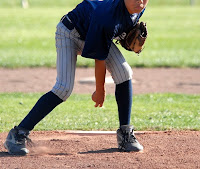Pitching mechanics – finish before you field!
January 20, 2011 by Coach McCreary
Filed under Coaching, Pitching
 |
| Photo 1: A common Little League finish. |
When pitchers are young, they are commonly told to “throw the pitch and get right into the fielding position.” This advice is not as much of a problem at the Little League level for the following reasons:
- The distance from the mound to the plate is shorter.
- Young players are still developing the skills needed to catch balls hit at them.
- Reaction times are slower so safety on batted balls at that level is more of a concern.
However, when players move into the bigger fields as they get older, a couple problems can emerge:
- The longer distance between the mound and home plate make it more important for pitchers to use their whole body when pitching – especially their mid-section.
- Many pitchers have developed the habit of not using their whole body.
Put the two problems together and we see many pitchers failing to finish properly. This usually leads to an increase in arm injuries after the jump to bigger fields as well as decreased performance on the mound. Here is a tip to combat these problems.
 |
| Photo 2 Front side faces at the start. |
Note: Even though I tend to see this mostly in the younger age groups (under 15), I have worked with high school, college, and even professional pitchers who still have not learned the following:
 |
| Photo 2: Whole back side (side of shoulder, hip, knee, and foot) now faces the batter after the pitch. |
Finish by reversing sides. When pitchers bring their knee up in the wind-up or anytime during the stretch, their whole glove side faces home plate – the side of the front shoulder, side of their front hip, side of their front knee, and the side of their front foot (Photo 2). The whole back side faces second base. Most pitchers do this part fairly well. However, when kids focus on finishing in the fielding position like the young man in Photo 1, they tend to finish with their shoulders, hips, and feet squared up to the batter. Therefore, their body only did a 90 degree turn from where it started. There is a lot more power a pitcher can get out of his body if he goes farther than 90 degrees. Pitchers should try to do a full 180 degree turn with their bodies (the back hip actually rolls somewhat over the front hip) in order to follow through correctly and maximize the use of the stronger, core muscles of the body – the hips, abdomen, back, etc. A pitcher should try to reverse everything when they finish their pitch. After the pitch, what used to be their front side is now facing second base. What started facing second base now faces home plate. Everything has reversed itself in the throwing and follow through process.
Only after pitchers get to this point should they concern themselves with fielding. In reality, when contact is made by the hitter (about the time Photo 2 was taken), the pitcher will never be in the fielding position if he is following through fully. That is why major league pitchers, even the best fielders, still get hit with line drives and ground balls back at them every now and then.
So it becomes a trade-off. Finish your pitch correctly to be more effective with less injuries but suffer a bit defensively or don’t finish well in order to field but suffer more arm stress and lower performance.
Your pick.
Tomorrow’s post will answer the question …





Leave a Reply